1.vue中echarts的使用
引入echarts后
- let myChart = echarts.init(document.getElementById('dsm'));//dsm为绑定的dom结构
- var option = {
- //backgroundColor:"#111c4e",
- tooltip: {
- trigger: 'axis'
- },
- legend: { //图表上方的图例显隐
- data:['光合有效辐射'],
- textStyle: {
- color: '#fff'
- }
- },
- color:['#E4FD0A'],
- grid: { //图表里上下左右的空间 间隙
- left: '3%',
- right: '8%',
- bottom: '3%',
- containLabel: true
- },
- xAxis: { //x轴属性
- type: 'category',
- name: '日期/时间',
- // boundaryGap: false,
- data: this.xZhou,
- axisLine:{
- lineStyle:{color:'#fff'} // x轴坐标轴颜色
- },
- axisLabel: {
- show: true,
- color: '#fff',
- fontSize:12,
- // rotate: 30
- }
- },
- yAxis: { //y轴属性
- type: 'value',
- name: '光合有效辐射',
- axisLine:{
- lineStyle:{color:'#fff'} // x轴坐标轴颜色
- },
- axisLabel: {
- show: true,
- color: '#fff',
- fontSize:12,
- // rotate: 30
- }
- },
- series: [ //为鼠标在图表中划过时显示的数据
- {
- name:'光合有效辐射',
- type:'line',
- stack: '总量',
- data:this.yZhou,
- lineStyle:{
- normal:{
- color: '#E4FD0A'
- }
- }
- }
- ]
- };
- myChart.setOption(option)
- window.addEventListener("resize", function () { //设置图表因窗口大小的变化进行变化
- myChart.resize();
- });
上述图表的显示效果为:

2.echarts与elementui-select的协同绑定
实现依据elementui-select的变化而变化图表。
- <template>
- <div class="content">
- <div class="contentDetail" v-show="isXM">
- <div class="close" @click="close"></div>
- <div class="chartContent">
- <el-select
- v-model="defaultyAxis" //利用v-model对默认数据defaultyAxis进行改变,实际绑定的数据是yAxisOption
- placeholder="请选择"
- class="chartSelect"
- popper-class="trsfChartSelect-popper"
- @change="renderChart()"
- >
- <el-option v-for="item in yAxisOption" :key="item" :label="item" :value="item"></el-option>
- </el-select>
- <div id="zsfChart"></div>
- </div>
- </div>
- </div>
- </template>
- <script>
- import { zsfEntity} from '@/api/sfcl.js'
- export default {
- name: 'Home',
- data() {
- return {
- isXM: true,
- yAxisOption: ['a', 'b'],
- defaultyAxis: '',
- dataOgj: {},
- }
- },
- mounted() {
- this.$comjs.addSimplePoint([100.62713539843939, 38.620863795306164]) //cesium挂载图标
- this.getChartDataAndRender()
- },
- methods: {
- close() {
- this.isXM = false
- this.$store.commit('getComponent1', '')
- },
- getChartDataAndRender(){ //axios获取异步数据
- var _this = this
- zsfEntity().then(res => {
- if(res.obj.length == 0){
- return
- }
- let keyArr = Object.keys(res.obj[0])
- for (let item of keyArr) {
- _this.dataOgj[item] = []
- }
- for (let item of res.obj) {
- for (let item1 of keyArr) {
- _this.dataOgj[item1].push(item[item1])
- }
- }
- _this.yAxisOption = keyArr.slice(1)//y轴实际数据 四项
- _this.defaultyAxis = _this.yAxisOption[0] //获取y轴默认数据
- _this.renderChart()
- })
- },
- //渲染图表
- renderChart() {
- let myChart = echarts.init(document.getElementById('zsfChart'))
- let option = {
- tooltip: {
- trigger: 'axis',
- axisPointer: {
- type: 'cross',
- label: {
- backgroundColor: '#6a7985'
- }
- }
- },
- legend: {
- data:[this.defaultyAxis],
- textStyle: {
- color: '#fff'
- }
- },
- grid: {
- right: '5%',
- left: '5%'
- },
- color: ['#E4FD0A'],
- xAxis: {
- name: "观测时间",
- type: 'category',
- boundaryGap: false,
- data: this.dataOgj.observeTime,
- axisLabel: {
- color: '#ffffff'
- // fontSize: 10,
- // rotate:30
- },
- axisLine: {
- lineStyle: {
- color: '#ffffff',
- type: 'dashed'
- }
- }
- },
- yAxis: {
- name: this.defaultyAxis,//挂载默认数据
- type: 'value',
- axisLabel: {
- color: '#ffffff',
- fontSize: 10
- // rotate:30
- },
- axisLine: {
- lineStyle: {
- color: '#ffffff',
- type: 'dashed'
- }
- }
- },
- series: [
- {
- data: this.dataOgj[this.defaultyAxis],
- type: 'line',
- name: this.defaultyAxis
- }
- ]
- }
- myChart.setOption(option)
- window.addEventListener('resize', function() {
- myChart.resize()
- })
- }
- },
- destroyed(){
- this.$comjs.removeSimplePoint()
- }
- }
- </script>
- <style lang="stylus">
- .trsfChartSelect-popper
- background: rgba(1,64,64,1)
- .el-select-dropdown__item.hover, .el-select-dropdown__item:hover
- background: rgba(0,0,0,0.5)
- .el-select-dropdown__item
- color: #fff
- </style>
- <style lang="stylus" scoped>
- @import '../../assets/styles/varibles.styl'
- .content
- position: absolute
- right: vw(10)
- top:vh(71)
- z-index: 100
- color: #fff
- background: $bgColor
- .contentDetail
- width:vw(1500)
- height:vh(348)
- position: fixed
- right: 70px
- bottom: 27px
- margin:auto
- z-index: 100
- color: #fff
- background: $bgColor
- border: 1px solid rgba(3,240,240,1)
- .close
- position:absolute
- right:vw(15)
- top:vh(10)
- cursor: pointer
- background-image:url("/images/lanhu/close.png")
- width: 20px;
- height: 20px;
- z-index: 1
- .baseInfo
- height: 75px;
- padding-top: 30px;
- .baseInfo-item
- width: 33%;
- display: inline-block;
- text-align: left;
- margin-bottom: 20px;
- padding-left: 80px;
- .baseInfo-item-icon
- vertical-align: middle
- margin-right: 14px
- .baseInfo-item-text
- vertical-align: middle
- .separator
- height: 1px
- background: #03F0F0
- .chartContent
- height: 100%
- .chartSelect
- position:absolute
- right: 63px
- margin-top: 20px
- width: 150px
- z-index: 1
- /deep/ .el-input__inner
- height: 28px;
- line-height: 28px;
- background:rgba(1,64,64,1);
- border-radius:2px;
- border:1px solid rgba(0,252,252,1);
- color: #fff
- /deep/ .el-input__icon
- line-height: 28px;
- #zsfChart
- height: 100%
- width:100%
- </style>
效果实现


补充知识:vue项目在同一页面中引入多个echarts图表 ,并实现封装,自适应和动态数据改变
vue-Echarts
公司最近做项目需要用到图表,以前是使用echarts,现在也是用这个,没什么好纠结的! 但是最近发现以前每次做图表之类的都没有封装,每次做图表都要从新去配置之类的,写了好多重复代码,感觉很累啊,所以自己把图表封装成子组件使用,代码工作量减轻了很多,而且子组件使用了数据进行监听和图表自适应屏幕大小,这样以后会方便很多了!
当然公司的项目肯定不能发出来了,我会做个简单的demo出来
先截个图吧!
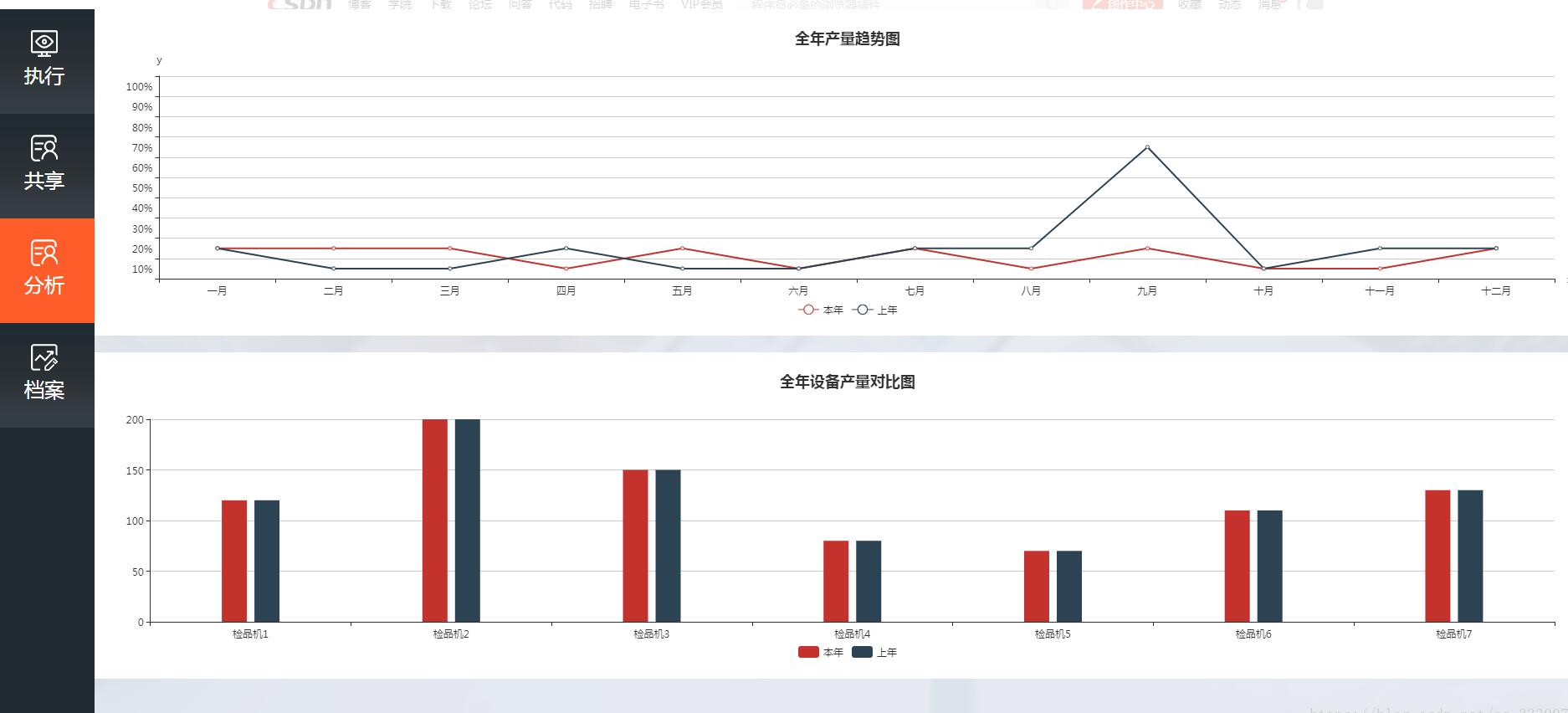
其实我也未作什么太复杂的工作,以前工作中,页面中要2个图表,我在methods:{}中写两个方法配置之类的,类似这样子:
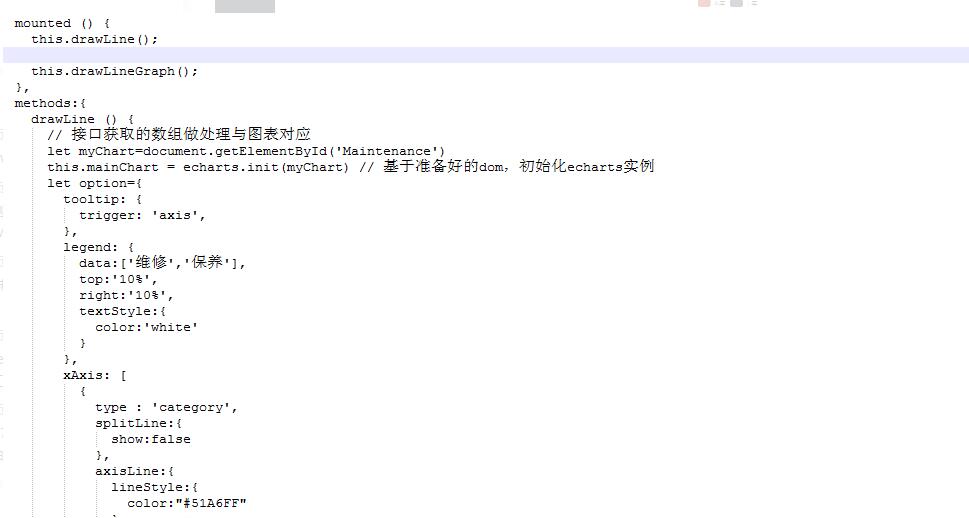
好了,首先第一步,使用echarts当然要引用了
1. vue 项目中 引用echarts
cnpm install echarts -S
执行完毕后再 main.js中引入
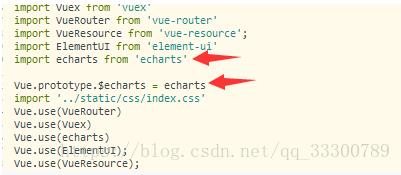
因为是pc端的项目,用了element ui (不重要),引入之后就可以在全局使用了,之前对这个不是很懂,每个要图表页面都引入echarts,就像这个样子:

使代码写的乱七八糟的,现在在全局引用了,就不需要在每个用图表的页面中引入了
2. 父子组件中使用图表,现在我做的这个页面把他分成两个部分,这个页面整体为父,两个图表为子组件,这样子
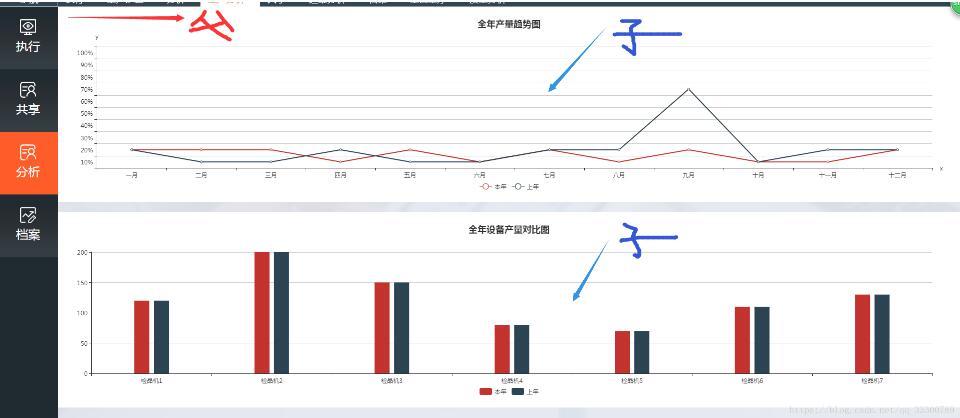
1.先看下父组件代码,样式类的请忽视

- import linegraph from '@/components/linegraph.vue'
- export default {
- data(){
- return{
- notAccess:false,
- ChartLineGraph2:null,
- option:{
- title: {
- text: '全年产量趋势图',
- left: 'center'
- },
- tooltip: {
- trigger: 'item',
- formatter: '{a} <br/>{b} : {c}'
- },
- legend: {
- left: 'center',
- data: ['本年', '上年'],
- bottom:0
- },
- xAxis: {
- type: 'category',
- name: 'x',
- splitLine: {show: false},
- data: ['一月', '二月', '三月', '四月', '五月', '六月', '七月', '八月', '九月', '十月', '十一月', '十二月']
- },
- grid: {
- left: '1%',
- right: '2%',
- bottom: '8%',
- containLabel: true
- },
- yAxis: {
- type: 'category',
- name: 'y',
- splitLine: {show: true},
- data:['10%','20%','30%','40%','50%','60%','70%','80%','90%','100%']
- },
- series: [
- {
- name: '本年',
- type: 'line',
- data: [0.8, 0.98, 0.96, 0.27, 0.81, 0.47, 0.74, 0.23, .69, 0.25, 0.36, 0.56]
- },
- {
- name: '上年',
- type: 'line',
- data: [1, 0.2, 0.4, 0.8, 0.16, 0.32, 0.64, 1.28, 5.6, 0.25, 0.63, 0.65, 0.12]
- },
- ]
- },
- option2:{
- title: {
- text: '全年设备产量对比图',
- left: 'center'
- },
- xAxis: {
- type: 'category',
- data: ['检品机1', '检品机2', '检品机3', '检品机4', '检品机5', '检品机6', '检品机7']
- },
- yAxis: {
- type: 'value'
- },
- legend: {
- left: 'center',
- data: ['本年', '上年'],
- bottom:0
- },
- grid: {
- left: '1%',
- right: '2%',
- bottom: '8%',
- containLabel: true
- },
- series: [
- {
- name: '本年',
- data: [120, 200, 150, 80, 70, 110, 130],
- type: 'bar',
- barWidth:30,
- },
- {
- name: '上年',
- data: [120, 200, 150, 80, 70, 110, 130],
- type: 'bar',
- barWidth:30,
- }]
- }
- }
- },
- mounted(){
- },
- components:{
- ErrorTip,
- linegraph,
- }
- }
这是父组件代码,两个图表不管是折线图还是柱状图都是使用 linegraph.vue这个子组件来进行的,因为我把echarts图表生成的配置项都放在了父组件里面,然后通过父组件给子组件传值实现图表生成,
3.父组件我们看完了,现在我们看下是如何封装的图表类linegraph.vue子组件,我先截图一下,然后解释:
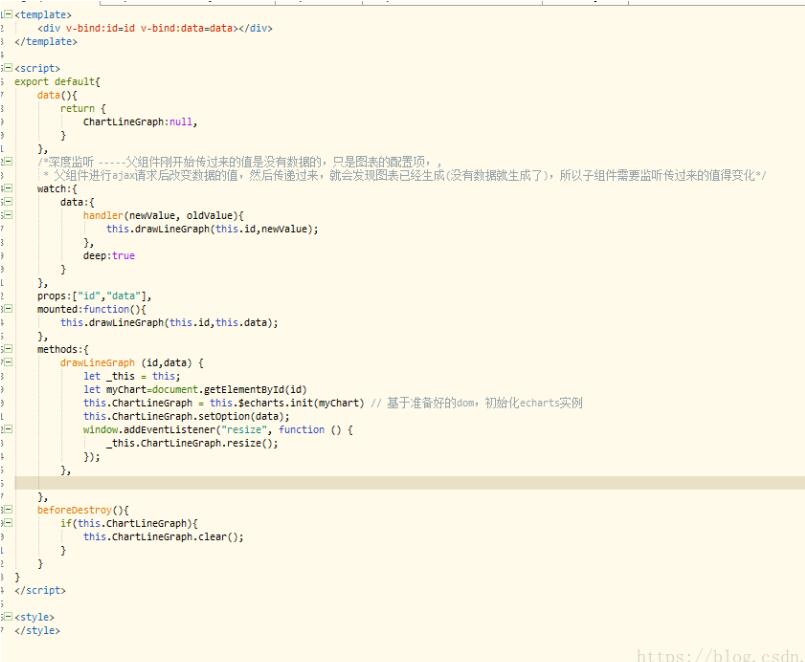
这里需要注意一下这几个问题,
第一个: 父子组件传值问题 ,父组件需要传id值和配置项的值给子组件生成图表,通过vue的prop传过来的id和data(配置项) ,具体怎么传值可看父子组件传值代码或百度;
第二点: 我们首先设想这样一个场景: 当父组件的传值 option或者option2 (图表配置项),刚开始在data()里面是设置为option:null,或者是一个空的对象,或者配置项缺少数据这部分,在methods中通过ajax调用接口获取到数据然后赋值给option,例如:this.option = 一个对象,可以成图表之类的,当option值未改变时就把option=null的值传递给了子组件,这样图表生成不了,像这样
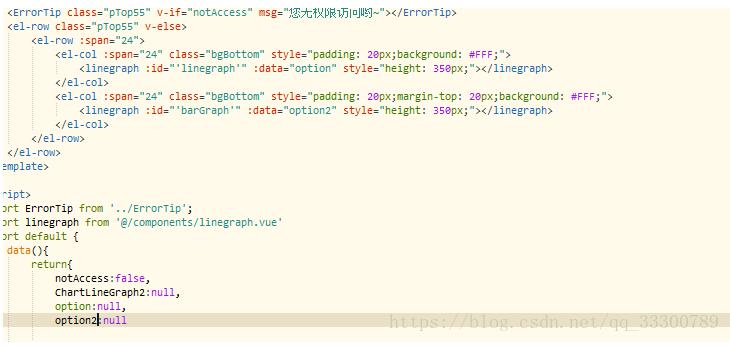

数据不能动态传值 ,数据不能动态传值! 要解决这个问题,必须用到vue watch的对象深度监听,我之前写了一篇watch,正好用上了

对子组件接受到的data(配置项)进行深度监听,当父组件通过ajax改变了传过来的data的值,图表将会重新渲染。
3.第三个问题
图表自适应,当屏幕大小改变时,图表也需要进行自适应,本来挺简单的东西,被我头脑转不过来,搞了一个小时,总算搞好了啊,其实之前写的就是在 子组件的 drawLineGraph()方法里面写入一个方法,这个方法
window.onresize =this.ChartLineGraph.resize;
还是出问题了,这个页面两个图表,结果只有后面的图表会自适应,前面的那个没反应???,我就蒙了,还以为自己方法写错了,真是蛋疼, 改成这样,那个this一定要注意,我就是搞错对象了,然后两个图表都可以自适应

好吧,这是我封装的echarts组件,没有进行ajax的对接操作,如果有问题,欢迎留言!
以上这篇vue中echarts的用法及与elementui-select的协同绑定操作就是小编分享给大家的全部内容了,希望能给大家一个参考,也希望大家多多支持服务器之家。
原文链接:https://blog.csdn.net/weixin_43163704/article/details/105140532













